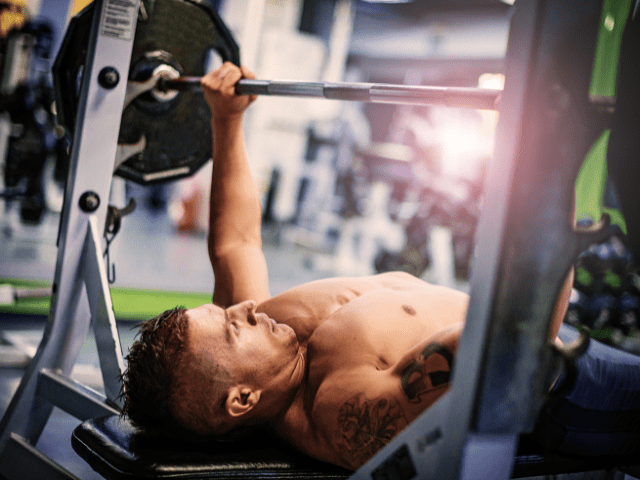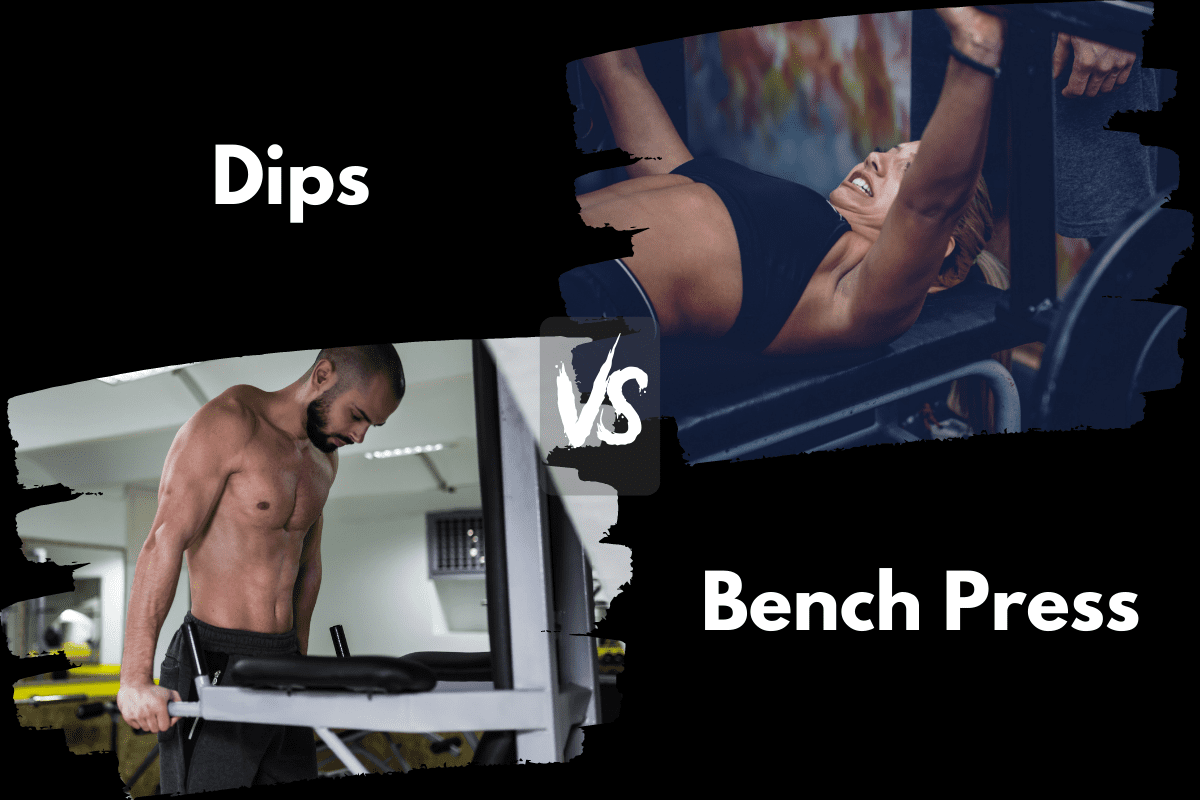Dips vs Bench Press (Which is Better For Strength?)
Both Dips and Bench Press are popular exercises that target the upper body, specifically the chest, triceps, and shoulders. While they may seem similar at first glance, there are a number of key differences between the two exercises that make them suitable for different training goals and skill levels.
In this article, I’ll take a closer look at Dips and Bench Press, comparing their benefits, differences, and who they are best suited for.
Whether you’re a beginner or an experienced lifter, this article will provide you with everything you need to know about Dips and Bench Press and how to incorporate them into your training program.
Dips

Equipment Needed
- Squat Rack
- Dip Attachment
- A Dip Station can be used as well if you have access to one.
Muscles Worked
- Chest
- Shoulders (Anterior Delt)
- Triceps
Step By Step Instructions
- Attach your dip rack to your rack. This process will vary based on your rack and dip attachment. Follow the manufacturer’s instructions closely.
- Set your dip rack just above waist height. This will allow enough room for your feet not to hit the ground while doing reps, but not so high you feel you have to jump up into your first rep.
- Starting position is hands on bars, arms extended, knees slightly bent and feet crossed (crossing feet is optional but does help with unwanted swinging in my experience.
- Descend down by bending the elbows and slightly leaning forward.
- Lower yourself under control until the triceps become parallel with the ground and then drive yourself back up to the starting position.
- Repeat until all reps are completed.
Coaching Points
The biggest mistake I see with dips is poor range of motion. If someone is struggling to be able to do reps, the easiest solution is to simply not lower yourself into a full rep, but this is incorrect. If a lifter cannot perform a full rep they should switch to one of the variations listed below.
The other issue I see my athletes run into is unwanted swinging front to back while doing reps. Stay under control, keep a consistent rep path, bend the knees and cross the feet. These are all solutions that I have seen help eliminate swinging while doing Dips.
Don’t have a dip attachment? Here are 10 alternatives for Dips you can do instead.
Benefits of Dips
There are several benefits to incorporating dips into your workout routine:
- Increased upper body strength: Dips require a significant amount of strength in the triceps, shoulders, and chest, and performing them regularly can help you build muscle and improve overall upper body strength.
- Enhanced functional strength: Dips require you to support your own body weight, which can help improve your functional strength and stability.
- Greater range of motion: Dips allow for a greater range of motion than many other upper body exercises, which can help improve your mobility and flexibility.
- Versatility: Dips can be performed with a variety of equipment, including bars, rings, and even parallel bars, giving you plenty of options for mixing up your workouts.
Overall, dips are a valuable exercise that can help you build strength, improve muscle definition, and enhance functional strength and mobility.
Bench Press

Equipment Needed
- Multi-purpose lifting rack
- Bench
- Barbell
- Bumper or Iron plates
Muscles Worked
- Chest
- Shoulders
- Triceps
- Biceps (Isometric and eccentric contributors)
Step-by-Step Instructions
- Set the height of the barbell so that when you unrack the barbell, you are only doing a very short upward concentric movement.
- Lie flat on your back on the bench.
- Keep your feet flat on the floor. (Some do find it comfortable to pull the feet back toward their butt as they arch).
- Keep your butt on the bench.
- Pull your shoulder blades together and keep the back of your head on the bench. You will slightly arch your back. Keep your core tight and keep the shoulder blades pulled back tight.
- Take a thumbs-width grip* from the knurling and completely close your grip. Keep your knuckles pointing toward the ceiling and squeeze the barbell.
- Later in this article, I will go over other popular grips and why they are used.
- Unrack the weight and take a deep breath.
- Control the barbell down during the eccentric movement and draw the barbell in, keeping the elbows at about a 45-degree angle away from the torso.
- The barbell will make contact with your torso right at the nipple line on the chest.
- Once contact is made, drive the barbell back up to the starting position.
Grips*
Close grip: This grip may be used to train the bench press with an emphasis on tricep development. By bringing the grip in, the chest and shoulder musculature is not stretched as much.
Wider grips: This grip may be used to train the bench press with an emphasis on chest development. I do not recommend this grip for athletes and especially for those with a history of shoulder injuries.
Coaching Points
By far the most common mistake with bench pressing (and almost all compound movements) is improper form. Because the lift is very technical, uses the whole body, and requires patience and persistence, lifters can potentially have incorrect form, go up in weight too quickly, and potentially injure themselves.
Remember why you are bench pressing. Goals matter. Make sure you are consulting with a coach or credible internet source so that you are engaging in beneficial bench press training for your future health and athletic success.
Do not let the elbows flare out away from the midline. The shoulders are incredibly vulnerable in these positions and the sheer force placed on the shoulders will lead to injury if the technique is not made a priority.
Bench Press Benefits
Some of the benefits of the Bench Press include:
- Improved upper body strength: The bench press is an effective way to build strength in the chest, triceps, and shoulders. By lifting progressively heavier weights, you can continuously challenge these muscle groups and see improvements in your strength and muscle size over time.
- Improved athletic performance: The Bench Press is a compound exercise that involves multiple joints and muscle groups. As a result, it can help to improve overall upper body strength and power, which can be beneficial for athletes in sports that require upper body strength and explosiveness, such as football or basketball.
- Increased bone density: Resistance training exercises like the Bench Press can help to increase bone density, which can be particularly beneficial for women as they age and their risk for osteoporosis increases.
Dips vs Bench Press: Which is Better?
Now, let’s do a side-by-side comparison between Dips and Bench Press to see if one exercise is better than the other for a few common lifting goals.
Better For Developing Size and Strength: Bench Press
I’m giving Bench Press the edge here, but it’s closer between the two exercises than some may think. Dips and Bench Press are two of the absolute best exercises for developing upper-body strength and muscle mass. I would include both exercises (along with Pull-ups) in my top three for upper-body exercises.
Bench Press has a slightly better ability to scale as lifters continue to get stronger. Yes, you can switch to Weighted Dips once Dips no longer present a good challenge anymore, but it’s harder to manage compared to Bench Press.
With Bench Press, as long as you have enough weight and a spotter, there is no limit to how much strength you can build.
Better For Beginners: Bench Press
There is no one-size-fits-all answer to this question, as the best exercise for a beginner will depend on their starting strength and any injuries or limitations they may have. However, there are a couple of reasons why the Bench Press may be a better choice for some beginners compared to Dips:
- Bench Press is typically easier to learn: The bench press is a relatively straightforward exercise that involves lying on a bench and pressing a barbell off your chest. In contrast, dips require more stability and coordination, as you have to lift your entire body weight using your arms while keeping your body straight. As a result, dips may be more challenging for beginners to learn and execute when first starting out.
- Bench Press allows for more precise weight control: When performing the bench press, you can adjust the weight of the barbell (or dumbbells) to match your strength level. This allows you to progress gradually as you get stronger. With dips, it can be more difficult to control the weight, as your body weight is the resistance. This can make it harder (although not impossible with modifications) for beginners to progress at a safe and appropriate rate.
Again, the best exercise for a beginner will depend on their individual circumstances.
Final Thoughts
I’ve just spent the last section of this article comparing which is better – Dips vs Bench Press. The truth is, there is no reason you shouldn’t have both exercises in your training program.
Both are excellent exercises for developing upper body strength and muscle mass. Incorporating both exercises into your training program can also add variety and keep your workouts from getting stale.
So, my suggestion would be instead of trying to decide between the two exercises, figure out how you can utilize both Dips and Bench Press in your training plan.

